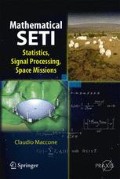Abstract
The gravitational focusing effect of the Sun is one of the most amazing discoveries produced by the general theory of relativity. The first paper in this field was published by Albert Einstein in 1936 [1], but his work was virtually forgotten until 1964, when Sydney Liebes of Stanford University [2] gave the mathematical theory of gravitational focusing by a galaxy located between the Earth and a very distant cosmological object, such as a quasar.
Access this chapter
Tax calculation will be finalised at checkout
Purchases are for personal use only
Preview
Unable to display preview. Download preview PDF.
REFERENCES
A. Einstein, “Lens-like action of a star by the deviation of light in the gravitational field,” Science, 84 (1936), 506–507.
S. Liebes, Jr., “Gravitational lenses,” Physical Review, 133 (1964), B835–B844.
V. Eshleman, “Gravitational lens of the Sun: Its potential for observations and communications over interstellar distances,” Science, 205 (1979), 1133–1135.
F. Drake, “Stars as gravitational lenses,” in G. Marx (Ed.), Proceedings of the Bioastronomy International Conference, Balatonfu¨red, Hungary, June 22–27, 1987, pp. 391–394.
N. Cohen, “The pro’s and con’s of gravitational lenses in CETI,” in G. Marx (Ed.), Proceedings of the Bioastronomy International Conference, Balatonfu¨red, Hungary, June 22–27, 1987, p. 395.
F. Drake and D. Sobel, Is Anyone Out There? Delacorte Press, New York, 1992. See pp. 230–234 in particular.
N. Cohen, Gravity’s Lens, Wiley Science Editions, New York, 1988.
C. Maccone, “Space missions outside the Solar System to exploit the gravitational lens of the Sun,” in C. Maccone (Ed.), Proceedings of the International Conference on Space Missions and Astrodynamics, Turin, Italy, June 18, 1992, published in Journal of the British Interplanetary Society, 47 (1994), 45–52.
C. Maccone, “FOCAL: A new space mission to 550AU to exploit the gravitational lens of the Sun,” a proposal for an M3 Space Mission submitted to the European Space Agency (ESA) on May 20, 1993, on behalf of an international team of scientists and engineers. Later (October 1993) reconsidered by ESA within the Horizon 2000 Plus space mission plan.
J. Heidmann and C. Maccone, “AstroSail and FOCAL: Two extra-Solar System missions to the Sun’s gravitational focuses,” Acta Astronautica, 35 (1994), 409–410.
C. Maccone, “The SETISAIL Project,” in G. Seth Shostak (Ed.), Progress in the Search for Extraterrestrial Life: Proceedings of the 1993 Bioastronomy Symposium, University of California at Santa Cruz, August 16–20, 1993, published in Astronomical Society of the Pacific Conference Series, 74 (1995), 407–417.
R. Orta, P. Savi, and R Tascone, “Analysis of gravitational lens antennas,” in C. Maccone (Ed.), Proceedings of the International Conference on Space Missions and Astrodynamics, Turin, Italy, June 18, 1992, published in Journal of the British Interplanetary Society, 47 (1994), 53–56.
John D. Kraus, Radio Astronomy, Second Edition, Cygnus-Quasar Books, Powell, OH, 1966. See pp. 6-115–6-118 in particular.
A. Hawkyard and A. Anselmi, QUASAT Industrial Phase A Study, Executive Summary, Aeritalia GSS Report QS-RP-A1-0004, 1988.
Author information
Authors and Affiliations
Corresponding author
Rights and permissions
Copyright information
© 2012 Springer-Verlag Berlin Heidelberg
About this chapter
Cite this chapter
Maccone, C. (2012). So much gain at 550 AU. In: Mathematical SETI. Springer Praxis Books(). Springer, Berlin, Heidelberg. https://doi.org/10.1007/978-3-642-27437-4_12
Download citation
DOI: https://doi.org/10.1007/978-3-642-27437-4_12
Published:
Publisher Name: Springer, Berlin, Heidelberg
Print ISBN: 978-3-642-27436-7
Online ISBN: 978-3-642-27437-4
eBook Packages: Physics and AstronomyPhysics and Astronomy (R0)

